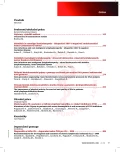Uncertainty of measurement results
Authors:
M. Budina
Authors‘ workplace:
SEKK, Pardubice
Published in:
Transfuze Hematol. dnes,24, 2018, No. 3, p. 142-150.
Category:
Overview
Uncertainty is an unavoidable part of every measurement result. It expresses the fact that we are unable to make absolutely precise measurements. That is why measurement results are not (cannot be) just a single number or value. Measurement results are always intervals (range of values) within which the true value lies with certain probability. The uncertainty approach represents not only the current view of the measurement theory (metrology) regarding the process of measurement and measurement results, but it is also implemented in all modern standards and quality management systems. Knowledge of the uncertainty of the measurement result provides both the subject performing the measurement and the customer (the result recipient) a basic idea regarding the quality of the result. This text aims to clarify the concept of measurement result uncertainty and how its existence is reflected in the routine work of doctors and laboratories.
Keywords:
measurement – result – uncertainty
Sources
1. Guide to the Expression of Uncertainty in Measurement (GUM). ISO, Geneva 1995.
2. TNI 01 0115. Mezinárodní metrologický slovník – Základní a všeobecné pojmy a přidružené termíny (VIM).
3. Data dostupná na stránce: www.sekk.cz.
4. Doporučení k výpočtu nejistot kvantitativních výsledků měření v klinických laboratořích, http://www.sekk.cz/infoservis/2014_nejistoty_doporuceni.pdf.
5. ČSN EN ISO 15189. Zdravotnické laboratoře – Požadavky na kvalitu a způsobilost.
Labels
Haematology Internal medicine Clinical oncologyArticle was published in
Transfusion and Haematology Today

2018 Issue 3
Most read in this issue
- Non-infectious non-malignant lymphadenopathy – sinus histiocytosis with massive lymphadenopathy, Rosai-Dorfman disease
- Next generation sequencing: basic bioinformatic terms and analytic protocols for DNA analysis
- Recommendations for the diagnosis and treatment of chronic lymphocytic leukaemia (CLL) – 2018
- Non-infectious and non-malignant lymphadenopathy – idiopathic (HHV-8 negative) Castleman disease
